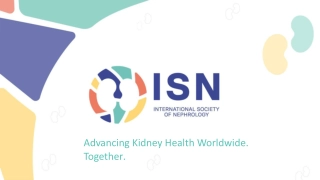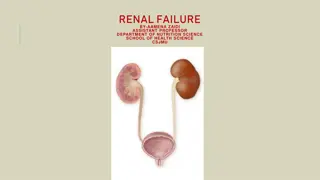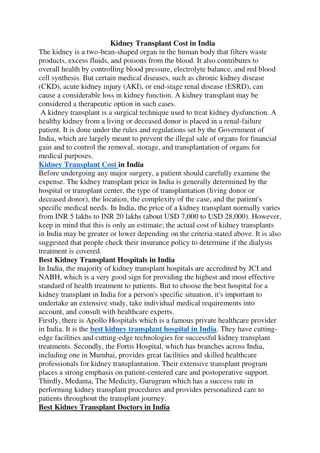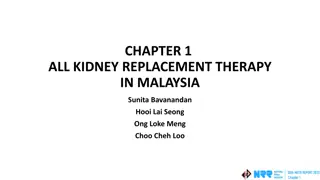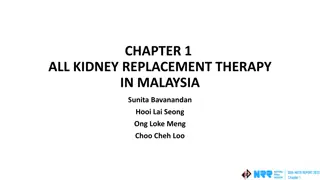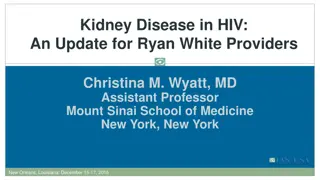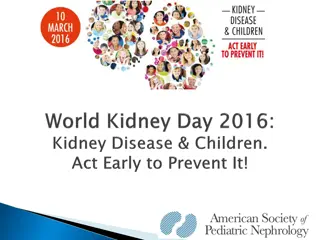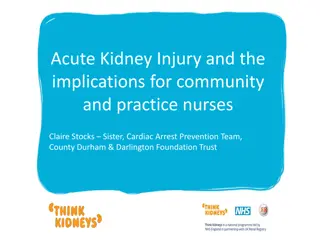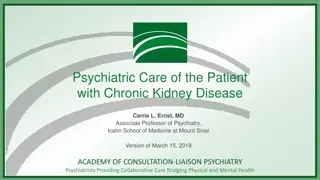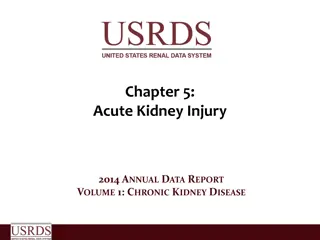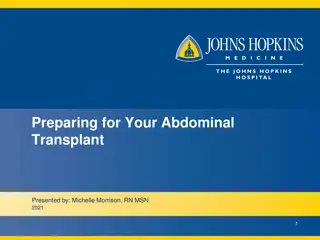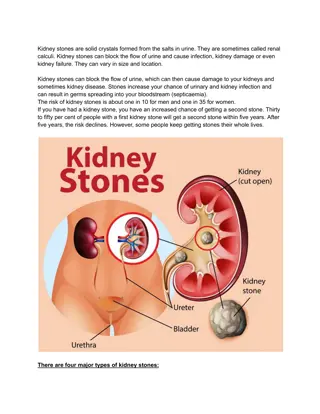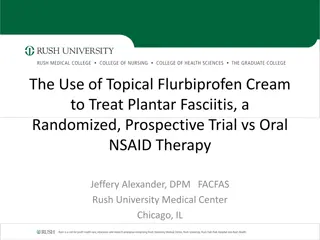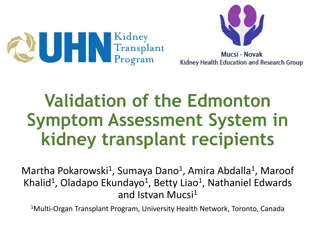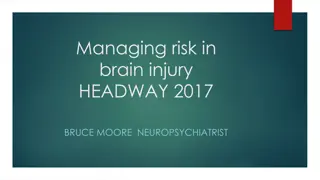Preventing Kidney Injury: Counseling High-Risk Patients on NSAID Use
Understand the impact of drugs on kidney function, identify patients at risk for acute kidney injury (AKI), and learn key opportunities for pharmacists to educate and prevent NSAID-induced AKI. AKI is common and preventable, particularly among elderly patients and those with diabetes, hypertension, or other comorbidities. Counseling on safer alternatives and self-care products can lead to significant clinical outcomes.
Download Presentation

Please find below an Image/Link to download the presentation.
The content on the website is provided AS IS for your information and personal use only. It may not be sold, licensed, or shared on other websites without obtaining consent from the author.If you encounter any issues during the download, it is possible that the publisher has removed the file from their server.
You are allowed to download the files provided on this website for personal or commercial use, subject to the condition that they are used lawfully. All files are the property of their respective owners.
The content on the website is provided AS IS for your information and personal use only. It may not be sold, licensed, or shared on other websites without obtaining consent from the author.
E N D
Presentation Transcript
Keeping Kidneys Safe Counseling High-Risk Patients on NSAID Use to Prevent Kidney Injury Amy Barton Pai, PharmD, BCPS, FASN, FCCP
Objectives Understand how prescription and non-prescription drugs affect blood flow through the kidneys (hemodynamics) Discuss clinical implications of community-acquired acute kidney injury (AKI) Describe patients at risk for AKI Identify key opportunities for pharmacists in education and prevention of NSAID-induced AKI 2
Benefits of the Program Opportunity to counsel on self-care products and direct the patient to safer alternatives Aligns well with Medication Therapy Management initiatives and does not require laboratory data to make an intervention A quick and easy intervention that could have a meaningful impact on clinical outcomes www.choosingwisely.org/doctor-patient-lists/choosing-a-pain-reliever/ 3
Community-Acquired Acute Kidney Injury AKI is a rapid loss of kidney function: an absolute increase in serum creatinine of 0.3 mg/dl ORa percentage increase in serum creatinine of 50% AKI is characterized by accumulation of nitrogenous wastes (uremic toxins), disruption of electrolyte (e.g. potassium) and acid-base balance Early symptoms can include fatigue, reduced urine output and edema Mehta RL et al . Acute Kidney Injury Network: report of an initiative to improve outcomes in acute kidney injury, Critical Care. 2007;11 (2):R31 4
AKI is Common and Preventable Drug-induced AKI accounts for 18% of AKI hospital admissions from the outpatient setting There is a 3- to 8-fold age-dependent increase in the frequency of community acquired AKI in patients >60 years old Loghman-Adham M, et al. Detection and management of nephrotoxicity during drug development. Expert Opin Drug Saf. 2012 Jul;11(4):581-96. Feest TJ et al. Incidence of severe acute renal failure in adults: results of a community-based study. BMJ 306:481 483, 1993 Coca SG et al. Acute kidney injury in the elderly: predisposition to chronic kidney disease and vice versa. Nephron Clin Pract. 2011;119 Suppl 1:c19-24. 5
Who is at High Risk for AKI? Patients with diabetes and/or hypertension because both cause kidney damage over time Multiple co-morbid conditions which are acquired with age (e.g., congestive heart failure, renal artery disease, severe liver disease) Patients with multiple co-morbid conditions who were recently discharged from the hospital Patients with co-morbid conditions that require the use of drugs that affect renal hemodynamics (e.g., ACE Inhibitors, ARBs, diuretics, NSAIDs) 6
Kidney Animation The following animation illustrates how NSAIDs alter normal kidney function. 7
Kidney Animation www.nkdep.nih.gov/resources.shtml?tab=4&vtab=6 8
Case #1 A patient comes in for a refill for levofloxacin for spontaneous bacterial peritonitis prophylaxis. Current medication profile: Lisinopril 20 mg daily Spironolatone 50 mg daily Lactulose 30 cc four times daily Rifaximin 550 mg twice daily Gabapentin 300 mg three times daily 9
Question Which of the following medications indicate that the patient is likely at high risk for AKI? Choose all that apply: 1. Lactulose 2. Rifaximin 3. Levofloxacin for SBP prophylaxis 4. Lisinopril 10
Answer Answers 1 through 4 all indicate that the patient is likely at high-risk for AKI Lactulose, rifaximin and levofloxacin all indicated the patient has advanced liver disease, which results in fluid moving into the periphery (e.g., ascites and poor blood flow through the kidney) ACE Inhibitors (lisinopril) dilate the efferent arteriole, which in the face of decreased intravascular volume, can severely reduce blood flow through the kidney 11
Patient/Pharmacist Video The following video illustrates an opportunity to counsel a patient on NSAID use. 12
Patient/Pharmacist Video www.youtube.com/watch?v=hPgQ24VMbNw 13
Long-Term Implications After an Episode of AKI Recent data have shown that AKI predisposes some patients to developing CKD Factors such as diabetes, hypertension, dehydration (e.g., from acute GI illness), sepsis, pre-existing kidney dysfunction, multiple organ failure, and advanced age increase the risk of developing CKD after an AKI episode Studies have shown that 72% of elderly who have an AKI episode develop CKD within 2 years Ishani, A. et al Acute Kidney Injury Increases Risk of ESRD among Elderly. J Am Soc of Nephrol 2009: 223-28 14
An Episode of AKI Affects Patients and Providers Patients with AKI have hospital stays 3.5 days longer than other patients AKI increases total cost of care (hospital) by up to $22,000 AKI is associated with an approximately 3-fold higher risk of death Drug-induced AKI can often be prevented Wang HE et al. Acute kidney injury and mortality in hospitalized patients. Am J Nephrol. 2012;35(4):349-55 Wu VC et al. Acute-on-chronic kidney injury at hospital discharge is associated with long-term dialysis and mortality. Kidney Int. 2011 Dec;80(11):1222-30. 15
Existing CKD is the Strongest Risk Factor for AKI Patients who have reduced kidney function or advanced CKD (not on dialysis) A typical medication profile for patients with advanced kidney disease may include agents such as: ACEi, ARBs phosphate binders (e.g., calcium acetate, sevelamer carbonate, lanthanum carbonate) Vitamin D analogues (e.g., calcitriol, paricalcitol, doxercalciferol) calcimimetics (cinacalcet) erythropoiesis stimulating agents (e.g., epoetin alfa, darbepoetin alfa) 16
Question Which of the following is true of ACE inhibitor and ARB effects on kidney hemodynamics? A. They dilate the efferent arteriole B. They dilate the afferent arteriole C. They reduce intraglomerular capillary pressure D. They increase intraglomerular capillary pressure E. A and C F. B and D 17
Answer E. A and C 18
Case #2 A 68-year-old patient presents to your pharmacy with a 2-day history of severe diarrhea from an enterovirus she got after taking care of her grandchild. She continued to take all her medications. She has a long past medical history of poorly- controlled hypertension and diabetes. Medications on her profile include lisinopril 20 mg once daily and furosemide 40 mg twice daily. 19
Question Why would diuretic use increase her risk of developing AKI? A. It constricts the afferent arteriole B. It dilates the efferent arteriole C. It promotes intravascular volume depletion D. It prevents compensatory efferent arteriole vasoconstriction 20
Answer C. It promotes intravascular volume depletion 21
NSAIDs: A Wolf in Sheeps Clothing An estimated 36 million Americans use over-the-counter analgesics on a daily basis Patients may not disclose using NSAIDs during medication reviews because they are over-the-counter These highly accessible medications may seem innocuous but carry a significant risk of disrupting blood flow to the kidneys and can precipitate AKI in high risk patients Hersh EV et al. Adverse drug interactions involving common prescription and over-the-counter analgesic agents. Clin Ther. 2007;29 Suppl:2477-97. 22
NSAIDs: A Wolf in Sheeps Clothing NSAIDs: Inhibit prostaglandin synthesis resulting in constriction of the afferent arteriole and decreased pressure in the glomerulus. NSAIDs are responsible for ~37% of drug-induced AKI cases, and the use of NSAIDs increases the risk of AKI by up to 58% in patients older than 65. Dose of ibuprofen > 1,200 mg/day are associated with higher risk COX-2 inhibitors are associated with a similar kidney risk profile as NSAIDs 23
Medications to Watch Out for with Concomitant NSAID Use ACEI/ARB, Diuretic, NSAID combo the potential triple whammy : ACEI/ARB vasodilates the efferent arteriole Diuretic decreases blood volume limiting perfusion Addition of the NSAID prevents vasodilatation of the afferent arteriole. There is very little perfusion to the glomerulus leading to reduced glomerular pressure, reduced filtration and AKI. 24
Case #3 The patient is a 56-year-old man who was discharged this morning from the hospital for volume overload and decompensated congestive heart failure. He had gained 10 kg in the past 2 weeks and had 4+ pitting edema on his legs when he was admitted. His medications on admission include lisinopril 40 mg orally once daily, metoprolol succinate 200 mg once daily, and furosemide 40 mg orally twice daily. Two days before admission, he started taking ibuprofen for the neck pain he developed from sleeping in his living room chair. Pertinent laboratory data on admission include a >50% increase in serum creatinine, from 1.93 mg/dL to 3.21 mg/dL and elevated potassium. His blood pressure on admission was 100/60 mm/Hg. 25
Question Which of the following factor(s) likely contributed to the patient s acute rise in serum creatinine? A. Decompensated CHF B. Lisinopril C. Furosemide D. Ibuprofen E. B and C only F. All of the above 26
Answer F. All of the above 27
How Providers Can Help Help to raise awareness of over-the-counter NSAIDs Advise patients on safe alternatives for pain relief Emphasize to patients why they are at high risk and promote kidney disease screening and education Visit www.nkdep.nih.gov for patient education tools 28
Acknowledgements NKDEP Pharmacy Working Group NIH Medical Arts Branch Village Apothecary, Woodstock, NY Justin George, Pharm.D., Albany College of Pharmacy and Health Sciences, for portrayal of the pharmacist Garry Maggio for portrayal of the patient 29


